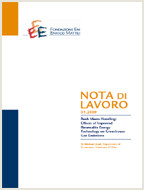EU ETS Facets in the Net: How Account Types Influence the Structure of the System

26.01.2016
C45, D85, L14, Q48, Q54, Q58
Emission Trading, EU ETS, European Union Transaction Log (EUTL) data, Account and Transaction Types, Network Analysis, Centrality Measures
Mitigation, Innovation and Transformation Pathways
Massimo Tavoni
In this work, we investigate which countries have been more central during Phases I and II of the European Emission Trading Scheme (EU ETS) with respect to the different types of accounts operating in the system. We borrow a set of centrality measures from Network Theory’s tools to describe how the structure of the system has evolved over time and to identify which countries have been in the core or in the periphery of the network. In doing this, we investigate by means of extensive partitions on the different types of accounts and transactions characterizing the EU ETS whether the role of intermediaries (approximated by Person Holding Accounts – PHAs) has affected the overall structure of the system. Preliminary findings over the period 2005-2012 suggest that PHAs have played a prominent role in the transaction of permits, heavily influencing the configuration of the system. This motivates further research on the impact of non-regulated entities in the EU ETS design.
***
Suggested citation: Borghesi, S., A. Flori, (2016), ‘EU ETS Facets in the Net: How Account Types Influence the Structure of the System’, Nota di Lavoro 8.2016, Milan, Italy: Fondazione Eni Enrico Mattei
